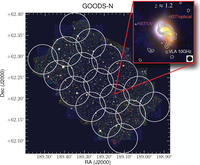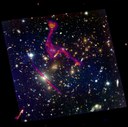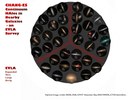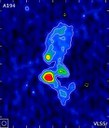Surveys
 VLA Sky Survey
VLA Sky Survey
Motivated by the enhanced capabilities of the Jansky Very Large Array, the VLASS will survey the entire sky north of Dec. -40 in three epochs, starting in September 2017. Each epoch will be separated by 32 months. The survey will be carried out in I,Q,U polarization at a frequency of 2-4GHz, and a resolution of 2.5". Data products will be made available to the community via the NRAO archive.
VLA 10 GHz Survey of GOODS-N
The VLA 10GHz Survey of GOODS-N is the first high-resolution (0.22 arcsec), high-frequency observational campaign to fully map an extragalactic deep field. The overarching goal of this VLA Large Program is to better trace the star formation history of the Universe. Surveying the extragalactic sky at 10GHz has the advantage of yielding higher angular resolution imaging while probing thermal (free-free) radiation of high-redshift galaxies, which is more directly proportional to the rate of massive star formation. The deep 10GHz images of GOODS-N are well matched to the resolution of existing HST/ACS optical and HST/WFC3-IR (continuum + Hα imaging) data from GOODS and CANDELS, and provide an extinction-free view for the morphologies of dusty star-bursting galaxies that dominate the star formation activity over 1<z<3.
VLA Frontier Fields
 The goal of the VLA Frontier Fields Survey is to characterize the radio continuum emission of high-redshift galaxies by leveraging massive clusters that magnify intrinsically faint, distant systems. This survey enriches the legacy of the Hubble Frontier Fields (HFF) by providing deep 3 and 6 GHz images of the MACSJ0416.1-2403, MACSJ0717.5+3745, and MACSJ1149.5+2223 galaxy clusters. The radio images have a depth of ~1uJy/beam and reach sub-arcsec resolution (see Table below). Together with the extensive ancillary data of the HFF, including deep HST and Spitzer data, the VLA Frontier Fields Survey enables the exploration of a variety of extragalactic topics, such as dusty star-forming galaxies at high redshift, the evolution of supermassive black holes, and the lensing clusters themselves. The VLA Frontier Fields project is a public legacy survey, and the image and catalog products are freely available.
The goal of the VLA Frontier Fields Survey is to characterize the radio continuum emission of high-redshift galaxies by leveraging massive clusters that magnify intrinsically faint, distant systems. This survey enriches the legacy of the Hubble Frontier Fields (HFF) by providing deep 3 and 6 GHz images of the MACSJ0416.1-2403, MACSJ0717.5+3745, and MACSJ1149.5+2223 galaxy clusters. The radio images have a depth of ~1uJy/beam and reach sub-arcsec resolution (see Table below). Together with the extensive ancillary data of the HFF, including deep HST and Spitzer data, the VLA Frontier Fields Survey enables the exploration of a variety of extragalactic topics, such as dusty star-forming galaxies at high redshift, the evolution of supermassive black holes, and the lensing clusters themselves. The VLA Frontier Fields project is a public legacy survey, and the image and catalog products are freely available.
CHANG-ES
 Continuum Halos in Nearby Galaxies - an EVLA Survey (CHANG-ES), was awarded 405 hours of observing time in the B, C and D array configurations. The survey aims to measure radio continuum emission of 35 nearby edge-on galaxies in C band (6 GHz) and L band (1.4 GHz). The edge-on inclination of the galaxies makes it possible to probe the structure and physics of disk-halo outflows. With 3 arrays of observations (B, C, and D), we will be able to examine, in detail, the disk-halo interface, as well as the larger scale halos that surround galaxies.
Continuum Halos in Nearby Galaxies - an EVLA Survey (CHANG-ES), was awarded 405 hours of observing time in the B, C and D array configurations. The survey aims to measure radio continuum emission of 35 nearby edge-on galaxies in C band (6 GHz) and L band (1.4 GHz). The edge-on inclination of the galaxies makes it possible to probe the structure and physics of disk-halo outflows. With 3 arrays of observations (B, C, and D), we will be able to examine, in detail, the disk-halo interface, as well as the larger scale halos that surround galaxies.
VLSSr

The Naval Research Laboratory (NRL) and NRAO announce the release of the Very Large Array (VLA) Low-frequency Sky Survey Redux (VLSSr). All data from the original VLSS survey has been re-imaged.
The VLSSr covers the sky above declinations -30 deg at a frequency of 74 MHz with 75 arcsec resolution and an average rms noise of 0.1 Jy/beam. It includes six previously unpublished fields and improved dynamic range in 95% of all fields. The clean bias has been halved and is now 0.66x the local rms. The largest angular size imaged has been roughly doubled to 36 arcmin, and the number of cataloged sources is increased by 35% to 95,000.
Improvements made include application of a substantially more accurate primary beam correction, smart-windowing to reduce clean bias, and the use of new automatic radio frequency interference removal and bright-source peeling algorithms. The original VLSS has been used as a starting sky model to enable higher-order Zernike fits to better model the ionospheric phase contributions.
Details of the improved reduction techniques can be found in W.M. Lane et al. (2012, Radio Science, 47, RS0K04) and a full description paper of the VLSSr is in preparation. Catalogs and images are on-line.
VLA-ANGST
 VLA-ANGST ("Very Large Array - ACS Nearby Galaxy Survey Treasury") is an NRAO Large Program to observe 35 nearby (distance <4Mpc) galaxies in the 21cm line of neutral atomic hydrogen (HI). All VLA-ANGST galaxies were observed at high spatial (~6", corresponding to ~100pc) and high spectral (0.65-2.6 km/s) resolution in the VLA B, C, and D array configurations. The galaxies are selected to map all gas-rich and actively star forming objects that are included in the "ACS Nearby Galaxy Survey Treasury" (ANGST). ANGST is a systematic survey to establish a legacy of uniform multi-color photometry of resolved stars for a volume-limited sample of nearby galaxies (D < 4 Mpc). The ANGST observations allow derivation of spatially resolved star formation histories (SFHs). The high spatial resolution of the VLA-ANGST observations allow meaningful comparisons to these ANGST SFH maps, as well as to surveys at other wavelengths such as LVL, KINGFISH, and 11HUGS. In addition, THINGS, LITTLE THINGS, SHIELD, and VLA-ANGST all follow similar observation strategies and data reduction procedures for a combined sample of >100 galaxies.
VLA-ANGST ("Very Large Array - ACS Nearby Galaxy Survey Treasury") is an NRAO Large Program to observe 35 nearby (distance <4Mpc) galaxies in the 21cm line of neutral atomic hydrogen (HI). All VLA-ANGST galaxies were observed at high spatial (~6", corresponding to ~100pc) and high spectral (0.65-2.6 km/s) resolution in the VLA B, C, and D array configurations. The galaxies are selected to map all gas-rich and actively star forming objects that are included in the "ACS Nearby Galaxy Survey Treasury" (ANGST). ANGST is a systematic survey to establish a legacy of uniform multi-color photometry of resolved stars for a volume-limited sample of nearby galaxies (D < 4 Mpc). The ANGST observations allow derivation of spatially resolved star formation histories (SFHs). The high spatial resolution of the VLA-ANGST observations allow meaningful comparisons to these ANGST SFH maps, as well as to surveys at other wavelengths such as LVL, KINGFISH, and 11HUGS. In addition, THINGS, LITTLE THINGS, SHIELD, and VLA-ANGST all follow similar observation strategies and data reduction procedures for a combined sample of >100 galaxies.
 ALFALFA
ALFALFA
The NRAO Data Archive now hosts the ALFALFA data cubes. The project presents a catalog of ∼31,500 extragalactic H I line sources detected by the completed Arecibo Legacy Fast ALFA (ALFALFA) survey out to z < 0.06, including both high signal-to-noise ratio (>6.5) detections and ones of lower quality that coincide in both position and recessional velocity with galaxies of known redshift. We review the observing technique, data reduction pipeline, and catalog construction process, focusing on details of particular relevance to understanding the catalog’s compiled parameters. We further describe and make available the digital H I line spectra associated with the cataloged sources. In addition to the extragalactic H I line detections, we report nine confirmed OH megamasers (OHMs) and 10 OHM candidates at 0.16 < z < 0.22 whose OH line signals are redshifted into the ALFALFA frequency band. Because of complexities in data collection and processing associated with the use of a feed-horn array on a complex single-dish antenna in the terrestrial radio frequency interference environment, we also present a list of suggestions and caveats for consideration by users of the ALFALFA extragalactic catalog for future scientific investigations.
ALFALFA observations were obtained from 2005-2012 with the Arecibo Observatory, which operated from 1963 until its untimely collapse in 2020. At the time the data were taken, the Arecibo Observatory was part of the National Astronomy and Ionosphere Center (NAIC), operated by Cornell University under a cooperative agreement with the National Science Foundation (NSF). These data products are the work of the entire ALFALFA collaboration who have contributed to the many aspects of the survey over the years, including generations of students from the Undergraduate ALFALFA Team. Their research was supported by grants from a variety of agencies, including the NSF and the Brinson Foundation. The ALFALFA team is indebted to - and mourns the loss of - survey lead Riccardo Giovanelli, who was an inspiration to us all.
Publications using ALFALFA data should cite Giovanelli et al. (2005) and Haynes et al. (2018), the definitive references for the survey. We also request that you include the following in the acknowledgements section of your publication:
"ALFALFA observations were obtained with the Arecibo Observatory. At the time the data were taken, the Arecibo Observatory was part of the National Astronomy and Ionosphere Center (NAIC), operated by Cornell University under a cooperative agreement with the National Science Foundation (NSF). These data products are the work of the entire ALFALFA collaboration who have contributed to the many aspects of the survey over the years. Their research was supported by grants from a variety of agencies, including the NSF and the Brinson Foundation."
LITTLE THINGS
LITTLE: The Local Irregulars That Trace Luminosity Extremes
THINGS: The HI Nearby Galaxy Survey
The LITTLE THINGS Survey was granted close to 376 hours of time with the Very Large Array (VLA) in the B, C, and D array configurations 2007-2008 to obtain deep HI-line maps of dwarf galaxies. The purpose is to determine how tiny galaxies form stars. Twenty-one dwarf irregular (dIm) and Blue Compact Dwarf (BCD) galaxies were observed, and are adding another 20 dwarfs with data from the VLA Archives. The new observations consist of 12 hours in B-array, 6 hours in C-array, and 2 hours in D-array for each galaxy. The channel separation is 2.6 km/s for 31 galaxies and 1.3 km/s for 11 galaxies.
The combined B/C/D arrays sample the galaxies at 6 arcsec, which is 110 pc at 3.7 Mpc, the average distance of our sample. This resolution shows clouds, shells, and turbulent structures that are important for star formation. We also produce maps at lower resolution that reveal the extended, low-density gas around star formation structures and trace the low density HI far beyond the stellar disks.
Science Team: Deidre Hunter (Lowell), Elias Brinks (Hertfordshire), Bruce Elmegreen (Watson Research Center), Michael Rupen (NRAO), Caroline Simpson (FIU), Fabian Walter (MPIfA), David Westpfahl (NM Tech), Lisa Young (NM Tech), Trisha Ashley (FIU), Phil Cigan (NM Tech), Dana Ficut-Vicus (Hertfordshire), Volker Heesen (Hertfordshire), Kim Herrmann (Lowell), Megan Johnson (NRAO), Se-Heon Oh (W Australia), Andreas Schruba (Caltech), Hong-Xin Zhang (Lowell).
NRAO Very Large Array Sky Survey (NVSS)
The NVSS has mapped the sky north of -40 deg declination at 1.4 GHz. The principal data products are: (a) 4 deg X 4 deg continuum maps " cubes" with three planes containing Stokes I, Q, and U images; (b) source lists; and (c) processed (u,v) data sets. The maps have 45 arcsec FWHM resolution and nearly uniform rms noise, about 0.45 mJy/beam = 0.14 K (Stokes I) and 0.29 mJy/beam (Stokes Q and U). The rms uncertainties in right ascension and declination vary from 0.3 arcsec for strong (S > 30 mJy) point sources to 5 arcsec for the faintest (S ~ 2.5 mJy) detectable sources.
Science Team: J. J. Condon, W. D. Cotton, E. W. Greisen, and Q. F. Yin (NRAO-Charlottesville); R.A. Perley and G.B. Taylor (NRAO-Socorro); J.J. Broderick (Virginia Polytechnic).




Connect with NRAO